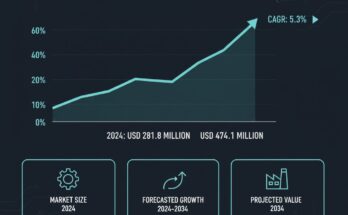The global acidified whey protein market is on a strong upward trajectory, supported by increasing consumer demand for high-protein beverages, sports nutrition products, and clean-label functional foods. According to a recent report by Fact.MR, the market is valued at USD 1.3 billion in 2025 and is projected to reach USD 2.4 billion by 2035, expanding at a CAGR of 6.1% during the forecast period.
As health-conscious consumers continue to prioritize natural, easily digestible, and performance-enhancing protein sources, acidified whey protein has emerged as a preferred ingredient across food and beverage applications.
Strategic Market Drivers
Surge in Demand for Clean-Label and Functional Nutrition
Modern consumers are increasingly seeking protein-rich products that are not only nutritionally efficient but also natural and additive-free. Acidified whey proteins fit perfectly into this trend by offering high-quality protein with excellent digestibility and a clean-label profile. Beverage formulators are incorporating these proteins into ready-to-drink shakes, smoothies, and fermented dairy alternatives, catering to athletes and active individuals.
Expanding Applications in Beverages and Sports Nutrition
The beverage industry has become the primary driver of market growth. Acidified whey proteins maintain solubility and texture stability at low pH levels, making them ideal for fruit-based drinks, nutritional beverages, and sports recovery formulations. Their rapid absorption rate makes them a top choice for pre- and post-workout products aimed at muscle recovery and performance enhancement.
Rising Health Awareness and Protein Consumption Trends
Globally, protein fortification has become a key trend in food innovation. Consumers are increasingly aware of the role protein plays in muscle health, weight management, and overall well-being. This shift is particularly strong among millennials and urban populations seeking convenient, on-the-go nutritional options.
Technological Innovations in Protein Processing
Advancements in filtration, acidification, and drying technologies have significantly improved the sensory properties and stability of acidified whey protein. Manufacturers are developing formulations that enhance taste, solubility, and shelf life, broadening the ingredient’s usability across dairy, beverages, and nutritional supplements.
Regional Growth Highlights
North America: Leading the Protein Revolution
North America remains the largest market for acidified whey protein, driven by the strong presence of sports nutrition brands, a mature health-conscious consumer base, and high demand for fortified beverages. The U.S. continues to lead innovation, with manufacturers focusing on plant-dairy protein blends and clean-label product launches.
Europe: Innovation and Functional Dairy Focus
Europe’s well-established dairy industry, led by countries like Denmark, Germany, and France, provides a strong foundation for acidified whey protein expansion. EU regulations supporting natural and sustainable food production are further encouraging clean-label and high-quality protein development.
East Asia: Rapid Growth Through Functional Beverage Adoption
East Asia, led by China, Japan, and South Korea, is witnessing significant growth in the functional beverage segment. Rising disposable incomes, urbanization, and increasing adoption of Western fitness and wellness trends are boosting the demand for protein-enriched drinks and supplements.
Emerging Economies: Untapped Potential
Latin America, South Asia, and the Middle East are emerging as high-potential markets due to growing awareness of sports nutrition, expanding middle-class populations, and an increasing shift toward balanced diets.
Market Segmentation Insights
By Type
- Whey Protein Concentrate (WPC): Most commonly used due to its cost-effectiveness and high nutritional value.
- Whey Protein Isolate (WPI): Gaining traction in premium and sports nutrition applications due to higher protein purity and lower lactose content.
By Application
- Sports and Performance Nutrition: Dominates the market, with acidified whey proteins supporting muscle growth and recovery.
- Functional Beverages: Witnessing rapid growth due to consumer demand for refreshing, high-protein, fruit-based drinks.
- Dairy and Food Applications: Used in yogurts, smoothies, and nutritional bars to enhance protein content and texture.
By Distribution Channel
- Retail (Supermarkets & Health Stores): Widely available as ready-to-drink beverages and protein powders.
- Online Platforms: Experiencing the fastest growth, supported by e-commerce health and fitness trends.
Challenges and Market Considerations
Despite positive growth trends, the acidified whey protein market faces a few challenges:
- Raw Material Price Volatility: Fluctuating milk and dairy costs can affect production margins.
- Competition from Plant Proteins: Rising popularity of plant-based alternatives requires whey protein manufacturers to innovate and differentiate.
- Technical Formulation Challenges: Achieving desired texture, stability, and taste at low pH levels requires advanced processing techniques.
- Sustainability Concerns: Environmental considerations in dairy production push manufacturers toward greener processing and sourcing practices.
Competitive Landscape
The market is highly competitive, characterized by innovation, strategic partnerships, and product differentiation. Key players are investing in research and development to improve functional performance, sustainability, and clean-label appeal.
Leading Companies Include:
Fonterra Co-Operative Group Limited, Glanbia Plc, Milk Specialties, Arla Food Ingredients Group, MILEI GmbH, Grande Cheese Company, Lactalis Ingredients, Hilmar Ingredients, Saputo Inc., and Kerry Group.
These companies are focusing on developing high-solubility, low-acid proteins optimized for beverage formulations. Strategic collaborations with food and beverage brands, as well as advancements in filtration and enzymatic processing technologies, are strengthening their market position.
Conclusion
The acidified whey protein market is set to achieve robust growth through 2035 as consumers increasingly favor convenient, functional, and high-protein products. With technological innovations, health-conscious lifestyles, and the global shift toward clean-label nutrition, manufacturers are poised to capture new opportunities in beverages, sports nutrition, and beyond.
The future of the market lies in innovation, sustainability, and adaptability factors that will define the next decade of growth in the global protein industry.



